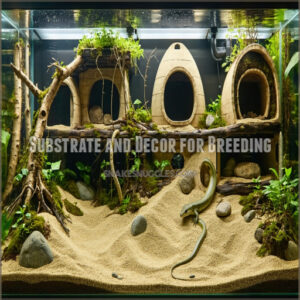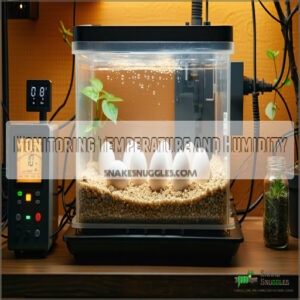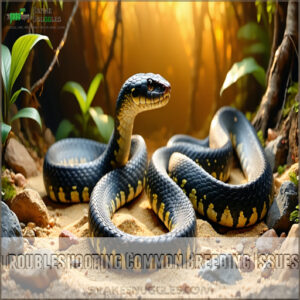This site is supported by our readers. We may earn a commission, at no cost to you, if you purchase through links.

Start by ensuring your female is at least two years old (males mature earlier) and healthy.
Breeding season kicks off in spring, so introduce the male to the female when she’s ovulating—male boas often show interest by vibrating their tails.
If she’s receptive, you’ll notice her relaxing and lifting her tail.
After mating, the female carries the babies for four months before giving birth to 4-20 live young.
Keep temperatures steady, around 80-90°F, with a basking spot at 95°F.
Curious about hatchling care? It’s simpler than you think, and understanding the basics of breeding season is key.
Table Of Contents
- Key Takeaways
- Kenyan Sand Boa Breeding 101
- Top 9 Essential Products for Breeding Kenyan Sand Boas
- 1. Copperhead Snake Hook Cage Length 33 Inches
- 2. Exo Terra Glass Reptile Terrarium Kit
- 3. Aspen Digs Shavings Bedding
- 4. Reptile Heating Pad with Thermostat
- 5. Reptile Basking Spotlight Bulbs
- 6. Natural Green Sphagnum Moss
- 7. Zoo Med Digital Thermometer Humidity Gauge
- 8. ReptiSafe Terrarium Water Conditioner
- 9. Heavy Duty Reptile Tweezers
- Environment and Habitat for Breeding
- Nutrition and Feeding for Breeding Kenyan Sand Boas
- Health and Wellness for Breeding Kenyan Sand Boas
- Breeding and Mating Strategies
- Incubation and Hatching
- Post-Breeding Care and Monitoring
- Troubleshooting Common Breeding Issues
- Advanced Breeding Techniques and Genetics
- Frequently Asked Questions (FAQs)
- When to breed Kenyan sand boa?
- How to tell if a Kenyan sand boa is pregnant?
- Can you crossbreed sand boas?
- How often do Kenyan sand boas breed?
- What is the gestation period for a Kenyan sand boa?
- How to tell if your sand boa is pregnant?
- Can you keep multiple Kenyan sand boas together?
- Can I breed Kenyan Sand Boas in a group setting?
- How to identify compatible Kenyan sand boa pairs?
- What behavioral changes indicate breeding failure?
- Conclusion
Key Takeaways
- Make sure females are at least two years old and males one year old before pairing them for breeding purposes; watch for tail vibrations and cloaca opening as signs of successful courtship.
- Maintain temperatures between 80-90°F, with a basking spot at 95°F, and ensure low humidity levels of 40-50% for a comfortable and stress-free environment.
- Gravid females need a warm, stable habitat and meals every 5-7 days; they’ll give birth to 4-20 live young after a four-month gestation period.
- After birth, set up secure enclosures for hatchlings with proper heat, a shallow water dish, and start feeding them pinky mice after their first shed.
Kenyan Sand Boa Breeding 101
Breeding Kenyan sand boas is exciting and rewarding if you know what you’re doing.
From preparing healthy adults to understanding their unique mating behaviors, a little planning goes a long way.
Understanding The Breeding Process
Kenyan sand boa breeding starts with knowing your snake’s readiness.
Females reach breeding age at two years, males slightly earlier.
Keep your boas healthy with proper temperatures and food.
Understanding their genetic traits helps plan for unique offspring.
Breeding cycles are key—monitor reproductive health to align with egg development stages, which leads to happier boas and a thriving clutch size!
Breeding Season and Mating Rituals
Breeding season usually kicks off in spring and rolls into early summer, with fascinating courtship rituals stealing the show.
Females typically give birth to 4-20 live young after a four-month gestation period.
You can learn more about Kenyan sand boa breeding.
Here’s what to watch for:
- Mating Habits: Males showcase interest through tail vibrations and gentle body rubs onto females—think of it as their version of a dance.
- Courtship Behavior: Receptive females relax their bodies and open their cloacas, signaling readiness.
- Snake Introductions: After copulation, separate the pair promptly to avoid stress—snakes need their space post-mating.
Mastering these breeding cycles boosts your success, keeping your boas happy!
Pregnancy and Gestation Period
How can you guarantee your gravid female Kenyan sand boa thrives during her 4-month gestation period?
Start with Gestation Care: create a stress-free environment, steady temperatures, and keep the humidity just right.
These Kenyan sand boas are docile in nature.
Watch for Pregnancy Signs like weight gain, belly swelling, or her seeking warmth.
You’ll often see 4-20 live young from healthy breeding females.
Focus on Fetal Development with proper feeding.
Avoid disruptions to minimize Birth Complications down the line!
Birth and Hatchling Care
Here’s the moment you’ve been waiting for: your sand boa babies have arrived!
After months of waiting, your female gives birth to a sand boa clutch size of 4-20 live young.
Now it’s all about hatchling care.
- Baby Enclosures: Use small, secure setups for each baby with proper heat and humidity.
- Newborn Feeding: Offer pinky mice after their first shed.
- Neonate Health: Watch for issues like birth complications or failure to eat.
Congrats!
Top 9 Essential Products for Breeding Kenyan Sand Boas
Breeding Kenyan sand boas successfully starts with having the right tools and gear.
Let’s cover nine must-have products that’ll make your breeding setup effective, safe, and stress-free for both you and your snakes.
1. Copperhead Snake Hook Cage Length 33 Inches

A good snake hook can make all the difference when handling Kenyan sand boas, especially during breeding season.
The Copperhead Snake Hook (33 inches) is built for safety and control.
With its sturdy stainless steel and copper materials, it’s strong yet lightweight—perfect for maneuvering boas without stress.
The angled hook offers precision, while the rubber grip keeps it secure in your hands, even if things get slippery.
Whether you’re checking a female’s sand boa clutch size or sexing Kenyan sand boas, this tool’s balanced design guarantees escape prevention and smooth handling.
For sand boa breeding age or general care, it’s a must-have essential!
2. Exo Terra Glass Reptile Terrarium Kit

Looking for a reliable sand boa enclosure? The Exo Terra Glass Reptile Terrarium Kit nails it for kenyan sand boa care. Its user-friendly features make reptile care a breeze.
Here’s why it’s a standout:
- Dual lockable doors: Makes feeding and cleaning safe and simple.
- Front ventilation: Keeps your snake’s home fresh and comfy.
- Waterproof base: Easy on cleanup for spills or messes.
- Stainless steel mesh lid: Great for airflow and escape prevention.
- Closable tubing inlets: Perfect for heaters or other gear.
Just inspect for shipping damage—it happens. Overall, it’s a durable pick. Pair smart Terrarium Setup with the right temperatures (85–90°F) and sand boa humidity, and you’re golden!
3. Aspen Digs Shavings Bedding
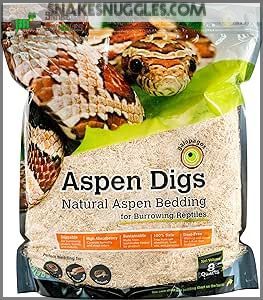
In the case of sand boa substrate, you can’t go wrong with Aspen Digs Shavings Bedding.
This bedding material is absorbent, controls humidity, and keeps odors in check, making it a top pick for any sand boa enclosure.
Your Kenyan sand boa will love burrowing into the soft, 100% safe shavings, free of harmful chemicals or parasites.
Plus, its dust-free design means better air quality for your snake and easier cleanup for you.
Whether you’re focused on Kenyan sand boa breeding or everyday care, this substrate option is practical and reliable.
Bonus? It even comes in a resealable bag for added convenience!
4. Reptile Heating Pad with Thermostat

Keeping your Kenyan sand boa cozy starts with temperature control, and a reptile heating pad with thermostat is your perfect heat source.
These pads maintain precise thermostat settings, guaranteeing your enclosure stays between 40-108°F.
Opt for a UL-approved model with durable adhesive, but place it carefully—beneath or on the side of the tank works best.
Bonus tip: an external thermostat adds an extra layer of pad safety.
Imagine this—a comfy sand boa, warm and happy, thanks to your setup.
Reliable reptile heating guarantees consistent sand boa temperature, which is essential for healthy breeding and stress-free snakes.
5. Reptile Basking Spotlight Bulbs
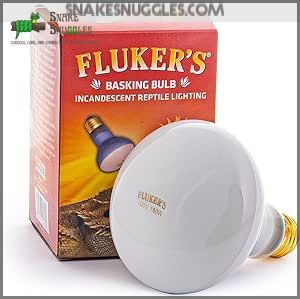
Giving your Kenyan sand boas the perfect environment starts with the right heat source.
Fluker’s Basking Spotlight Bulbs are a solid pick for providing the radiant heat they need to thrive. These bulbs simulate the natural basking areas found in the wild, helping regulate temperature and digestion. Pair them with reliable lamp fixtures for consistent lighting and safety.
Always monitor temperatures—spotlight heat shouldn’t exceed recommended ranges (75-95°F).
Here’s why these bulbs work:
- Bulb Types: Plus options, like infrared, for day or night use.
- Spotlight Safety: Avoid overheating with sturdy fixtures.
- Temperature Control: Keeps your snake’s heat needs in balance.
6. Natural Green Sphagnum Moss
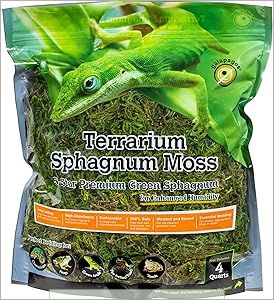
When setting up for Kenyan Sand Boa breeding, you’ll need quality moss substrate that supports humidity control and comfort.
That’s where Natural Green Sphagnum Moss shines—it’s perfect for maintaining the right sand boa humidity level during breeding or for sand boa incubation.
These snakes thrive in arid regions of Africa.
Its long fibers lock in moisture, creating a cozy, humid environment your boas will appreciate.
Plus, it adds natural green decor that’s easy on the eyes.
This moss is sustainable, non-toxic, and simple to handle.
Regular moss maintenance is a breeze since it lasts long without mess.
It’s versatile, too—great for both breeders and anyone serious about kenyan sand boa genetics.
7. Zoo Med Digital Thermometer Humidity Gauge

Maintaining perfect temperature control and humidity levels is key to Kenyan sand boa breeding, and the Zoo Med Digital Thermometer Humidity Gauge makes it a breeze.
Its accurate digital displays keep you informed, so your sand boas stay healthy and stress-free.
The waterproof probe works great for air or substrate checks, making it versatile for sand boa incubation setups.
Tip: the suction cups aren’t the best, so try using command hooks instead.
With long battery life and reliable gauge accuracy, you’ll spend less time tinkering and more time enjoying your snakes.
Serious breeders swear by it for tracking sand boa health!
8. ReptiSafe Terrarium Water Conditioner

Water quality isn’t just a box to check—it’s a cornerstone of Kenyan sand boa breeding and overall reptile health.
Tap water can sneak in harmful chemicals like chlorine, chloramines, and ammonia, making ReptiSafe Terrarium Water Conditioner the go-to fix.
A few drops in your snake’s water bowl instantly detoxifies and adds electrolytes, keeping hydration stress-free.
Think of it as armor for their tiny systems, giving hatchlings a healthy head start.
Whether managing tank maintenance or enhancing aquarium safety, ReptiSafe simplifies water conditioning effortlessly.
For thriving snakes and stress-free care, this little bottle is a breeder’s secret weapon.
Don’t skip it!
9. Heavy Duty Reptile Tweezers

When feeding or handling your Kenyan sand boa, heavy-duty reptile tweezers can make your life a whole lot easier.
With a 15-inch reach, these stainless steel tweezers protect your hands while offering precision.
Perfect for tasks like presenting food or securing delicate items, they’re a breeding tool every keeper needs.
- 15-inch length keeps you safe.
- Non-slip tips for a firm grip.
- Corrosion-resistant material lasts.
- Great for feeding tongs or small tasks.
- Handy for all reptile breeders.
Environment and Habitat for Breeding
Creating the right habitat for breeding Kenyan sand boas isn’t complicated, but it’s essential.
You’ll need to focus on proper temperatures, humidity, and a cozy, well-prepared setup to keep your snakes healthy and stress-free.
The key to success lies in creating a setup that is both stress-free and well-maintained, which directly contributes to the health of your snakes.
Setting Up a Breeding Enclosure
Got your gear? Let’s create the perfect breeding enclosure! A 24x18x18" tank works great.
Use aspen or sand for your breeding substrate, so boas can burrow.
Proper ambient conditions are crucial for successful breeding.
Toss in a couple of secure hiding spots—plants, rocks, or even a hide box do wonders. Keep it simple!
A well-planned enclosure design creates a comfy habitat, boosting your Kenyan sand boa breeding success.
Humidity and Temperature Control
If your Kenyan sand boa could talk, it’d say, “Keep me cozy!”
Aim for humidity levels of 40-50% and a temperature range of 80-90°F, with a basking spot at 95°F.
Use heat sources like mats and thermostats to maintain a steady thermal gradient.
A bit of climate control goes a long way—monitor levels regularly for happy boas.
Hot tip: consistency is key!
Lighting and UVB Requirements
Too much heat isn’t the problem in Kenyan sand boa breeding, but lighting plays a role.
Add low-level UVB lighting like T5 or T8 bulbs, keeping intensity at 0.5–1.0 UVB within 12 inches.
Stick to natural lighting cycles—12 hours on, 12 off—paired with heat lamps.
This lighting balance supports calcium absorption and maintains proper temperature levels for healthy, stress-free reptiles.
Substrate and Decor for Breeding
Creating the perfect reptile enclosure means giving your Kenyan sand boas what they need for a comfy, productive space.
Start with 3-4 inches of substrate depth like aspen or sandy bedding for burrowing. Appropriate Kenyan sand boa substrates are readily available.
Keep decor materials practical—minimal rocks, branches, or hides are enough. Balance the tank layout for function, not flair, and consider breeding boxes for privacy.
Proper substrate helps with humidity control too.
- Use soft substrate like aspen or sand.
- Keep decor minimal to reduce stress.
- Include breeding boxes for private nesting.
Nutrition and Feeding for Breeding Kenyan Sand Boas
Feeding your Kenyan sand boas properly is key to their health and successful breeding.
Stick to a schedule with nutrient-rich meals, and your snakes will thrive and stay ready for action.
Dietary Requirements for Breeding
Healthy breeding starts with smart food choices and proper nutrient needs.
Stick to prey items about 1-1.5 times your Kenyan sand boa’s head diameter.
Balance their diet with occasional dietary supplements like calcium and Vitamin D3 to support strong bones.
It’s like feeding them a customized meal plan—you’re ensuring breeding nutrition that keeps your snakes strong and ready.
Feeding Schedules and Recommendations
Feeding schedules are key to keeping your Kenyan sand boas healthy and ready for breeding. Stick to a regular plan, and don’t stress—it’s easier than you think.
- Meal Frequency: Adults thrive on meals every 7-10 days. Pregnant females need more energy, so feed them every 5-7 days.
- Prey Items: Change things up occasionally. Offer different mice sizes to provide variety.
- Food Size: Choose prey about 1-1.5 times the width of your snake’s head—no bigger, no smaller.
Nutrient-Rich Foods for Optimal Health
In the context of sand boa feeding during Kenyan sand boa breeding, stick to healthy prey options like mice, rats, and even quail.
Rotate them to maintain nutrient cycling. Adults typically feed every 10-14 days, and following a proper feeding schedule is essential for their health.
Sprinkle in vitamin supplements for calcium and mineral balance. For an extra boost to sand boa health, try Reptilinks.
A well-fed boa with the right protein sources will breed and thrive effortlessly!
Health and Wellness for Breeding Kenyan Sand Boas
Keeping your Kenyan sand boas healthy during breeding is key to their success and well-being.
Watch for common issues like infections or stress, and act fast to provide the right care.
Common Health Issues in Breeding
Breeding Kenyan sand boas is rewarding, but you’ve gotta watch out for health issues.
Snakes can face respiratory issues, parasites, or even metabolic bone troubles if enclosures aren’t up to snuff.
Female boas might struggle with egg-laying difficulties or dehydration in low humidity.
Catching sand boa diseases early keeps things smooth.
- Respiratory issues from poor hygiene
- Parasite control gone wrong
- Genetic disorders causing birth defects
- Skin problems like bad sheds
- Egglaying difficulties in gravid females
Preventative Measures and Care
Keeping your Kenyan sand boas healthy isn’t rocket science, but it takes commitment.
Stay sharp with weekly health checks, track shedding and eating habits, and don’t skimp on reptile husbandry—spot-clean and sanitize like a pro.
Control environmental safety, keeping temperatures stable (85-90°F) and humidity low.
Here’s a quick guide:
| Task | Frequency | Why It Matters |
|---|---|---|
| Spot-clean tank | Weekly | Prevents disease buildup |
| Temperature check | Daily | Guarantees snake comfort |
| Parasite check | Monthly | Stops infestations |
| Water refresh | Every 2-3 days | Avoids mold or bacteria |
| Feeding log | Weekly | Tracks nutrition habits |
Remember, a little care prevents big health issues later!
Recognizing Signs of Illness
Spotting health issues in your Kenyan sand boa early can save headaches (and vet bills).
Watch for respiratory issues like wheezing or mouth gaping, feeding difficulties, sudden weight loss, or unusual skin lesions.
Shedding problems or eye problems like swelling or discharge are red flags too.
If your usually lively snake seems sluggish, don’t wait—reptile health problems can snowball quickly.
A quick trip to a reptile-savvy vet can work wonders.
Breeding and Mating Strategies
In the context of breeding Kenyan sand boas, selecting the right pair and knowing their behaviors can make all the difference.
You’ll need to time introductions carefully and watch for signs of interest, like tail movement and tongue flicking—don’t worry, it’s less awkward than it sounds!
Selective Breeding for Desired Traits
Selective breeding is the art of crafting beautiful Kenyan sand boa morphs by focusing on standout traits.
Explore genetic selection and fine-tune your breeding goals with these priorities:
- Color & Patterns: Bright hues and unique designs make morph creation exciting.
- Temperament: Everyone loves a chill, docile sand boa.
- Size: Balanced, healthy growth wins every time.
- Health: Strong immune systems trump flashy looks.
- Genetic Mutations: Study heritability for safer trait inheritance.
- Breeding Pairs: Match boas for genetic diversity.
- Trait Inheritance: Track traits to refine future generations.
Remember, patience is key—great morphs take time!
Line Breeding and Outbreeding
In the context of Kenyan sand boa genetics, line breeding sharpens traits like unique patterns but risks issues from inbreeding.
On the flip side, outbreeding methods mix genes, boosting genetic diversity and creating hybrid vigor—think healthier, hardier boas.
Pick a breeding pair wisely based on your goals.
Balancing these breeding strategies guarantees strong snakes with fewer genetic hiccups.
Breeding for Color and Pattern
If you’re chasing eye-catching Kenyan sand boa morphs, mastering color genetics and pattern morphs is key.
By understanding snake morphology and applying smart breeding strategies, you can create stunning genetic variations.
Mix dominant morphs or double recessive genes for unique snake morphs while keeping ethics first.
Always balance creativity with health—it’s about beauty and well-being, not just looks.
Incubation and Hatching
When it’s time to incubate Kenyan sand boa eggs, keeping the temperature and humidity stable is vital for healthy hatching.
With the right tools and a watchful eye, you’ll guarantee the babies arrive strong and ready to thrive.
Incubation Techniques and Equipment
Getting your incubator design right makes all the difference.
Keep the incubation temperature steady at 82–85°F with proper temperature control. Use sphagnum moss or similar for the egg-laying site, keeping incubation humidity at 60–70%.
Maintain airflow to avoid mold. Monitor those Kenyan sand boa eggs closely—healthy eggs mean happy hatchlings later.
Pro tip: Don’t skimp on a good thermometer! Investing in a reliable reptile incubator is vital for successful breeding with the right incubation temperature and proper temperature control.
Monitoring Temperature and Humidity
In the context of incubation, nailing down temperature control and humidity levels is critical.
Keep the Kenyan sand boa temperature steady at 80-85°F and incubation humidity around 40-50%.
Here’s a quick checklist:
- Use digital tools like thermometers and hygrometers for precise environmental monitoring.
- Set reliable thermostat settings to manage heat sources.
- Check daily for fluctuations—consistency is key to avoiding stress and ensuring healthy eggs!
Hatching and Neonate Care
Hatching day is here—finally!
Once your baby Kenyan sand boas arrive, move them to a secure, escape-proof enclosure.
Add a shallow water dish, lightly mist the space, and keep their setup warm.
After their first shed, usually about a week later, start Neonate Feeding with pinky mice.
Handle gently to build trust and avoid stress.
Monitor Newborn Health closely, ensuring strong growth and smooth Baby Handling routines.
Post-Breeding Care and Monitoring
Once your Kenyan sand boa has given birth, it’s important to keep a close eye on her recovery.
Your hatchlings’ health is also a priority, and a little extra care now, like tracking meals, goes a long way for a healthy start.
Making sure everyone stays warm is crucial, as this attention to detail can significantly impact their well-being, and a little extra care now can make a big difference.
Monitoring Health and Wellness
Keeping your Kenyan sand boa healthy after breeding isn’t hard if you follow a few key steps.
A little TLC goes a long way! Here’s what to watch for:
- Clean the enclosure regularly: Snake hygiene matters.
- Monitor weight: Sudden weight changes? It’s time for a health check.
- Nail their diet: Proper nutrition advice—think appropriately sized, healthy prey—helps avoid issues and supports recovery.
- Shedding watch: Bad shed stuck around? It points to humidity trouble or other health issues.
Address it quickly, and remember, a steady feeding routine keeps things on track.
If something feels off, don’t hesitate to consult a reptile vet for expert snake health advice!
Providing Optimal Care for Newborns
Taking care of baby Kenyan sand boas is simple with the right setup.
Start with a secure, escape-proof baby enclosure. Keep the temperature at 80-85°F, humidity around 40-50%, and offer a shallow water bowl.
For infant nutrition, feed pre-killed pinky mice every 3-5 days. Gently handle the hatchlings; they’ll tolerate handling better over time.
Choose aspen bedding for burrowing or reptile carpet to prevent ingestion. These live young thrive when their needs align with proper hatchling care practices.
Maintaining ideal temperatures is vital, and using reptile heating systems can help achieve this.
Record Keeping and Data Tracking
Keeping track of everything is key to mastering Kenyan sand boa breeding.
Use detailed records to stay ahead of the game.
Here’s what to log:
- Hatchling Records: Birthdates, weights, and lengths.
- Feeding Schedules: Meals given, refusals, and preferences.
- Health Charts: Track sheds, illnesses, or odd behavior.
- Genetic Tracking: Parental traits and morphs.
- Breeding Logs: Mating dates and outcomes.
Stay organized, simplify your breeding!
Troubleshooting Common Breeding Issues
Breeding Kenyan sand boas doesn’t always go smoothly, but most issues have simple solutions.
Whether it’s infertility, mismatched pairs, or picky eaters, you can tackle these challenges with patience and the right approach.
Dealing With Infertility and Breeding Disputes
Infertility causes and mating issues often come down to breeding stress, poor compatibility, or snake nutrition.
If your pair isn’t cooperating, swap males or check for genetic disorders through testing.
Stress-free enclosures, proper diet, and understanding reproductive biology can help.
Sometimes it’s just bad timing—patience is key.
Got stubborn snakes? A second opinion from a reptile vet never hurts!
Understanding snake breeding problems and breeding health issues is essential for successful reproduction.
Overcoming Breeding Challenges
Breeding challenges giving you a headache? Let’s tackle them!
Trouble often comes down to nutrition deficits, environmental factors, or even overlooked genetic issues.
Double-check your Kenyan sand boa’s enclosure—temps, humidity, and heat gradients matter.
Nutrition is key; feed quality, size-appropriate meals.
If disputes arise, separate snakes or try another male.
Understanding their reproductive biology means staying patient and flexible.
Small adjustments can solve big breeding obstacles!
Advanced Breeding Techniques and Genetics
Breeding Kenyan sand boas using advanced techniques lets you create stunning morphs while maintaining healthy genetics.
By understanding traits like recessive and dominant genes, you can pair snakes strategically for exciting results without risking their well-being.
Genetic Diversity and Line Breeding
Line breeding Kenyan sand boas can spotlight stunning morphs but comes with risks.
To keep your breeding program healthy, focus on genetic variation.
Here’s how:
- Pair unrelated snakes to promote hybrid vigor.
- Use a breeding pair with complementary traits for ideal gene expression.
- Monitor heritable traits through detailed logs to track sand boa genetics and avoid recessive deformities.
Mutations and Genetic Defects
Genetics keep things interesting—and tricky—with Kenyan sand boas.
Missteps can lead to genetic disorders like "wobble syndrome" or weakened patterns.
Testing protects against surprises in recessive morphs while maintaining strong morph inheritance.
Think of it like baking; balance creative color mutations with defect prevention for healthy boas.
| Genetic Challenge | Impact | Solution |
|---|---|---|
| Recessive Mutations | Hidden Health Risks | Genetic Testing |
| Albino Defects | Skin Sensitivities | Ethical Pairing |
| Inbreeding | Weakened Offspring | Diverse Breeding Lines |
Advanced Breeding Strategies and Techniques
Think of genetic testing as your flashlight—shedding light on traits for smarter snake breeding.
Nail balanced breeding cycles by mixing selective breeding for morph creation and hybridization techniques.
Kenyan sand boas thrive on diverse genes, so outbreeding spices things up, while line breeding polishes traits.
Watch snake behavior like a hawk—it’s your best clue for smooth reptile breeding adventures.
Frequently Asked Questions (FAQs)
When to breed Kenyan sand boa?
You’ll want to breed Kenyan sand boas in spring or summer, once females hit two years old and 300 grams, and males are at least a year old.
Cooling tanks beforehand boosts their chances of success.
How to tell if a Kenyan sand boa is pregnant?
Picture a round, swollen belly on your boa, like it just had a big meal but it doesn’t fade.
Increased heat-seeking, inverted laying, and less food interest are clear pregnancy signs to watch for.
Can you crossbreed sand boas?
You can’t crossbreed sand boas with other species—they’re genetically incompatible.
Stick to pairing Kenyan sand boas with their kind if you’re breeding, and hey, there’s plenty of morph variety to explore without crossbreeding, which involves understanding the importance of genetic compatibility.
How often do Kenyan sand boas breed?
Kenyan sand boas breed like clockwork, usually once a year during spring and summer.
With proper care, they thrive in captivity.
You’ll notice males getting active while females release pheromones to spark courtship.
What is the gestation period for a Kenyan sand boa?
The gestation period for these sand boas usually lasts 4-6 months, but it can vary.
During this time, females may seek extra belly heat, show inverted postures, and even continue eating smaller meals if offered.
How to tell if your sand boa is pregnant?
If your sand boa looks like it swallowed a tiny beach ball, it might be pregnant.
Look for belly swelling, increased heat-seeking behavior, aggression, or flipped-upside-down resting.
A pre-birth shed also signals pregnancy.
Can you keep multiple Kenyan sand boas together?
It’s best to house Kenyan sand boas separately.
These snakes prefer solitude, minimizing stress and competition.
If you must keep multiple, make certain enough space, hides, and food are provided, but fights or stress can still occur due to competition.
Can I breed Kenyan Sand Boas in a group setting?
Over 30 baby boas per litter sounds cool, but group breeding isn’t ideal.
Males may fight, and tracking which female’s gravid gets tricky.
Stick to pairing one male and one female for stress-free success.
How to identify compatible Kenyan sand boa pairs?
Pick a male over one year old and 75 grams, and a female at least two years old, 300 grams, and 21 inches long.
If they’re healthy and exhibit interest, you’re golden!
What behavioral changes indicate breeding failure?
When breeding fails, you’ll notice males lose interest and stop courting, while females may show no ovulation signs like swelling or behavioral changes.
Both might seem indifferent, just hanging out like roommates instead of partners.
They will exhibit behaviors that indicate a lack of interest in each other, which is a clear sign of failed breeding, and this can be observed through the absence of courting.
Conclusion
Breeding Kenyan sand boas is like planting a seed—you provide the right conditions, then watch nature work its magic.
By nailing their temperature, enclosure, and feeding needs, you’re setting the stage for happy, healthy hatchlings.
Keep an eye on their health, stay organized with records, and handle challenges with patience.
The process may take time, but the reward of seeing those tiny boas thrive makes it all worth it.
Ready to get started with Kenyan sand boa breeding? You’ve got this!





